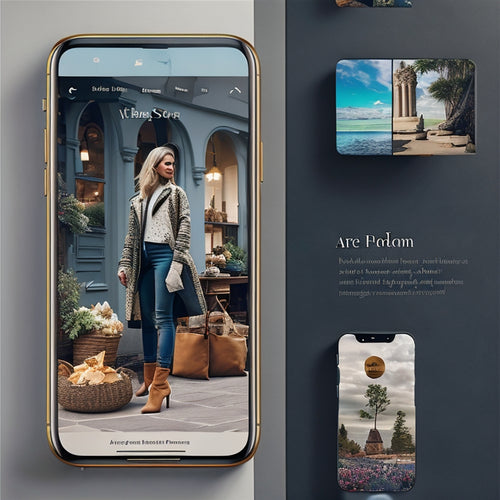
Master the Art of Shirt Picturing
Share
You're on the verge of revealing the secrets of creating breathtaking custom tees. To master the art of shirt picturing, you'll need to harmonize every design element, from color to fabric. First, choose a shirt color that complements your design, then optimize your design file for printing. Select a fabric that suits your design and printing method, and position your design strategically for visual impact. Guarantee a crisp, high-quality image by preparing a high-grade image file with specific requirements. With these fundamentals in place, you'll be poised to create stunning tees that make a lasting impression. Now, take the next step to refine your craft.
Key Takeaways
• Choose a shirt color that complements your design to create a visually appealing custom t-shirt.
• Optimize your design file with high-definition images, compatible formats, and accurate color modes for high-quality prints.
• Select the suitable printing method, such as DTG, DTF, screen printing, or all-over printing, to achieve your desired design outcome.
• Position your design strategically on the shirt to create maximum visual impact and consider t-shirt design trends.
• Ensure a crisp, high-quality image by following specific design file preparation requirements and using high-grade image files.
Print on Demand for Custom T-Shirts
With Print on Demand (POD), you can effortlessly create custom t-shirts with your unique designs, leveraging a convenient and efficient production process that eliminates the need for bulk orders or inventory storage. This means you can focus on what matters most - custom design inspirations and marketing strategies to drive sales.
POD services allow you to print and ship products directly to customers, reducing the risk of inventory overload and ensuring a seamless customer experience. To further enhance customer engagement, consider pricing strategies that offer competitive rates without compromising on quality.
Steps for Shirt Picturing Success
You're now ready to turn your design into a reality by following a step-by-step process that guarantees your custom shirt turns out exactly as envisioned.
To achieve shirt picturing success, focus on three essential elements:
-
Color selection: Choose a shirt color that complements your design, making sure the image pops and doesn't get lost in the fabric.
-
Image optimization: Optimize your design file for printing, considering resolution, format, and size to secure a crisp, high-quality image.
-
Fabric choice and design placement: Select a fabric that suits your design and printing method, and strategically position your design to maximize visual impact.
T-Shirt Printing Methods Explained
Four primary t-shirt printing methods dominate the industry, each offering unique benefits and results that cater to specific design needs and preferences. You can choose from direct-to-garment (DTG) printing for high-quality, detailed prints, direct-to-film (DTF) printing for vibrant colors and durable prints, screen printing for a popular stencil-based technique, or all-over printing for covering the entire shirt with your design.
When selecting a printing method, consider your t-shirt design trends and custom shirt color choices. For instance, DTG printing is ideal for intricate designs, while DTF printing suits bold, colorful graphics. By understanding each method's strengths, you can create stunning, high-quality custom shirts that meet your design vision and appeal to your target audience.
DIY Shirt Picturing Techniques
Exploring DIY shirt picturing techniques allows you to personalize your tees without breaking the bank, and iron-on transfers with transfer paper are a popular method for achieving professional-looking results at home.
With a heat press, you can guarantee a durable and long-lasting finish.
Here are some benefits of DIY shirt picturing techniques:
- Creative freedom: You have complete control over the design and printing process.
- Cost-effective: DIY methods can be more budget-friendly than outsourcing to a professional printer.
- Instant gratification: You can wear your custom tee as soon as the ink is dry.
Shirt Design File Preparation
To secure your custom t-shirt design looks its best, prepare a high-grade image file that meets the specific requirements of your chosen print-on-demand service.
You'll want to optimize your design file by using high-definition images with a minimum of 300 DPI. Confirm file format compatibility by saving your design as a JPEG, PNG, or SVG file, as these are widely accepted by most print-on-demand services.
Additionally, consider the color mode and resolution of your design file to secure it prints accurately.
From Design to Delivery
With your design file ready, you're now just a few clicks away from turning your vision into a tangible product that's shipped directly to your customers. This is where the magic happens, and your design customization comes to life.
You've put in the effort to create a unique design, and now it's time to bring it to the masses.
Here's what you can expect:
- Fast and reliable shipping logistics that guarantee your customers receive their orders on time
- High-quality prints that meet your design expectations
- A seamless customer experience that reflects positively on your brand
Tips for Shirt Picturing Mastery
You've successfully navigated the process of creating custom t-shirts, and now it's time to refine your skills and discover the secrets to shirt picturing mastery.
To elevate your game, focus on color selection that complements your design. Enhance your design by considering the fabric choice and printing method.
Ensure high-quality results by using high-resolution images with ideal resolution. For a polished look, adjust the design's size and positioning on the shirt.
Finally, don't forget to test your design by ordering a sample before selling online.
Frequently Asked Questions
What Is the Ideal Image Resolution for Custom T-Shirt Designs?
When creating custom t-shirt designs, you'll want to use high-resolution image files with design software that guarantees color accuracy. For best printing results, aim for 300 DPI with CMYK color mode to guarantee vibrant, detailed prints.
Can I Use a Photo Taken With a Smartphone for Shirt Picturing?
Can you really capture perfection with a smartphone snap? While smartphone cameras have improved, their limitations in quality and resolution might compromise your design. Consider alternative image sources, like high-res cameras or stock photos, for a crisper, more professional finish.
How Do I Prevent Custom T-Shirts From Fading Quickly?
When creating custom t-shirts, you guarantee they don't fade quickly by selecting high-quality printing techniques like DTG or DTF, and following fabric care instructions, which can greatly impact the longevity of your designs.
Are There Any Environmental Concerns With Print-On-Demand T-Shirts?
Don't you want to wear your values on your sleeve, literally? When opting for print-on-demand t-shirts, you're supporting sustainable practices with eco-friendly materials, reducing carbon footprint, and promoting responsible waste management.
Can I Sell Custom T-Shirts With Licensed Characters or Logos?
'When selling custom t-shirts, you'll need to make sure you're not infringing on copyrights or trademarks. Be cautious of licensed characters or logos, and consider fair use or parody designs to avoid legal issues.'
Related Posts
-
Enhancing Online Shopping: Introducing Vimotia's Shoppable Video Experience
Vimotia Shoppable Videos UGC is a cutting-edge app that revolutionizes the online shopping experience by introducing ...
-

What Is the Best Instagram Feed App for Shopify
This article aims to provide an objective analysis of the best Instagram feed app for Shopify. By adhering to an aca...
-

What Apps Are a Must for Shopify
This article aims to provide an informative overview of the essential apps for Shopify, a popular e-commerce platfor...

